How To Make Seitan from Whole Wheat Flour
Oct 31, 2011, Updated Jul 03, 2017
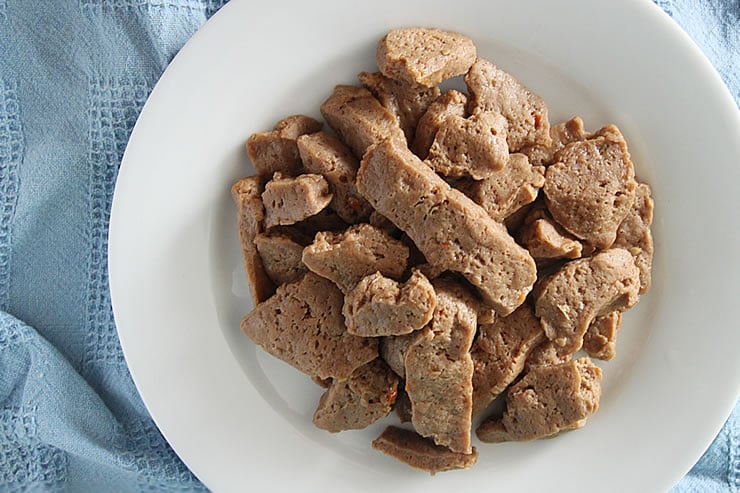
When I stopped eating meat about fifteen years ago I relied, like many new vegetarians, on processed meat substitutes: frozen soy burgers, fake “riblets,” and “chik” nuggets in brightly colored packages. For many people these products ease the transition to a new way of eating, but using them can also become an additive-laden crutch. Over the years I’ve transformed my own diet and, I have abandoned the freezer section for the kitchen with delicious, simple, unprocessed results.
The meat substitute I make most often is a batch of spicy black bean burgers, so tasty my omnivorous husband requests them regularly. But he also enjoys (and has even made) seitan.
Seitan. Mock duck. Wheat meat. Whatever you call it, seitan originated in Asia where vegetarian Buddhists used it in place of meat for centuries. Its spread in popularity is credited to the macrobiotic food movement which began in Japan. The word is not actually Japanese, but based in it, which is why I pronounce it “say-TAHN,” not “Satan.”
What is seitan?
Seitan is simply wheat gluten, spiced and simmered. My previous method used store-bought vital wheat gluten as a shortcut, but Andrew learned that the process to make vital wheat gluten is not replicable at home. Undeterred and not without a little spite, I set out to make it from scratch: Flour and water, here I come! After reading mopey stories about how time-consuming the process was, I was pleasantly surprised that the actual hands-on time was little more than the “shortcut” method, and I enjoyed the end product more than previous batches.
Gluten is the protein found in wheat which, when mixed with water, forms into long stretchy strings that give bread its structure. When you develop those strands, rinse off the starch, and cook the gluten bits, you get seitan. The chewy texture is quite similar to meat — I’ve definitely had seitan-based dishes that I’ve had to double-check that they were actually meat-free.
How to make seitan at home from whole wheat flour
The process is simple, but does take some time. Make a large batch and freeze the extra.
Mix whole wheat flour and water into a stiff dough to develop the gluten. I used my stand mixer.
Cover with cold water and let soak for a few hours or overnight. This both allows the gluten to develop and the starch to “loosen up.”
Knead the dough and rinse with cold water until the water runs clear. It takes about 10 minutes. I used a mesh sieve to help.
You’ll be left with only the gluten, which is considerably smaller in volume than your starting mass of flour. This was a smaller batch than the recipe lists, and 12 ounces of flour yielded just over 5 ounces of seitan.
Those stringy strands are exactly what we want.
Form the gluten into a ball; squeeze out as much water and air as possible. The smaller you can shape the piece of gluten, the firmer texture your finished seitan will have. Cut the gluten into pieces using a bench scraper or sharp knife.
Bring a pot of broth to a boil and drop in the pieces of gluten. Simmer the gluten for about half an hour until the broth is almost gone.
I like to sauté my seitan before using it, or you can store it refrigerated, covered in the broth (add more water if needed) for about a week.
This is a very basic recipe, but you can add spices to the dough when mixing, or play with your broth ingredients to add flavor components at any stage.
My favorite ways to eat seitan are on BBQ mock duck pizza, curried mock duck banh mi, in stir fries and fajitas. Leave the packaged “strips” on the shelf and with just a little effort, make your own unprocessed seitan.
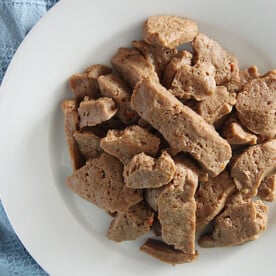
Homemade Seitan from Whole Wheat Flour
This is a very basic recipe. Add spices to the flour before mixing, or change-up the broth for different flavors. You can use homemade or store-bought vegetable stock, or mix up the quick broth outlined below.
Ingredients
Dough
- 6 cups whole wheat flour, 24 ounces / 900 grams
- 2 cups cold water
Broth
- 4 cups water
- 1/4 cup soy sauce, or Braggs liquid aminos
- 1/2 onion, chopped
- 1 tablespoon miso paste
- 1 medium tomato, cut in quarters
- 2 cloves garlic
Instructions
- Combine flour and water. Mix until a stiff-but-cohesive dough is formed. Use a dough hook and a stand mixer if possible.
- Form dough into a ball, place in a bowl, and cover with cold water. Cover and let stand 4-8 hours.
- Knead the dough and rinse until water runs clear, about 10 minutes. Squeeze dough and press out as much liquid and air as possible. Use a sharp knife or a bench scraper to cut the gluten into bite-sized pieces.
- Combine ingredients for broth (or use your preferred vegetable stock) and bring to a boil. Drop gluten pieces into boiling broth and return to a boil. Reduce heat to a simmer. Cook, turning gluten pieces occasionally, until the broth is mostly absorbed and reduced, about 30 minutes. Discard onion and tomato pieces.
- To use seitan right away, drain and sauté in a little oil. To store, cover with broth and keep refrigerated up to a week, or frozen. Thicken and reduce broth as a gravy if desired.
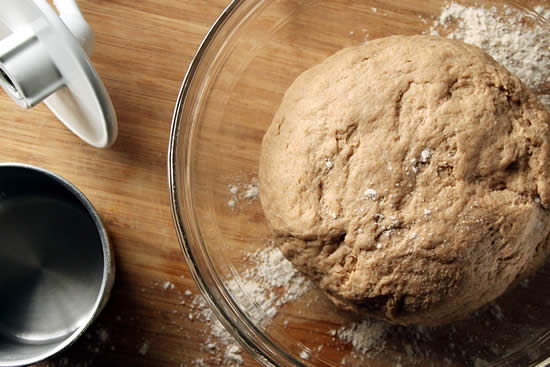
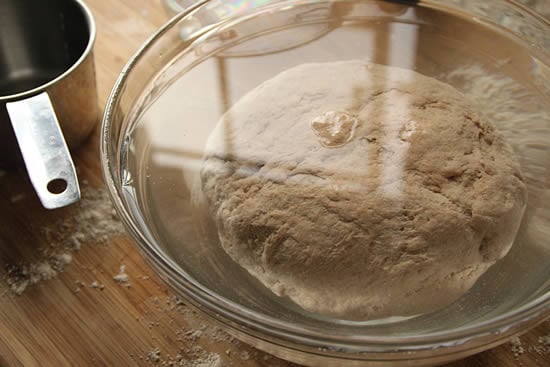

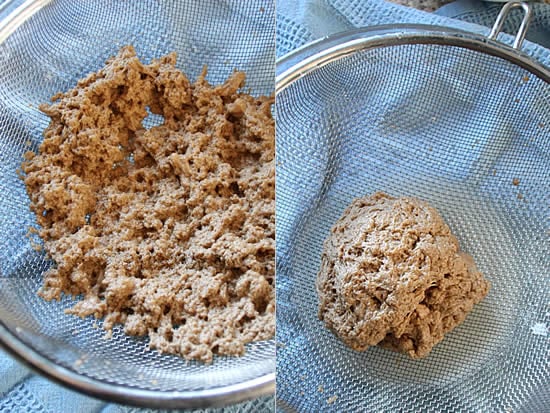
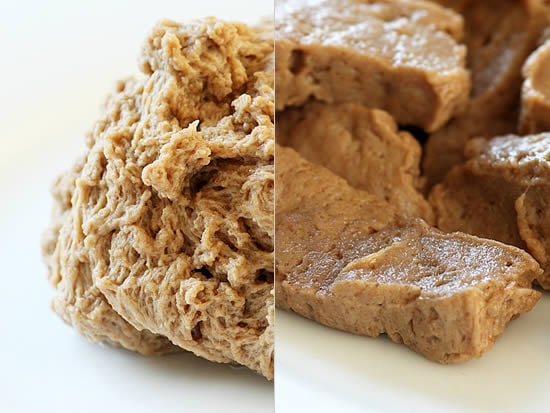
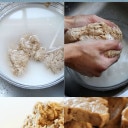

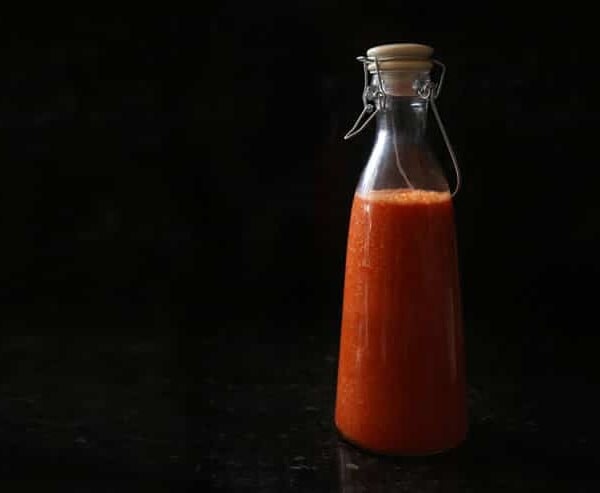

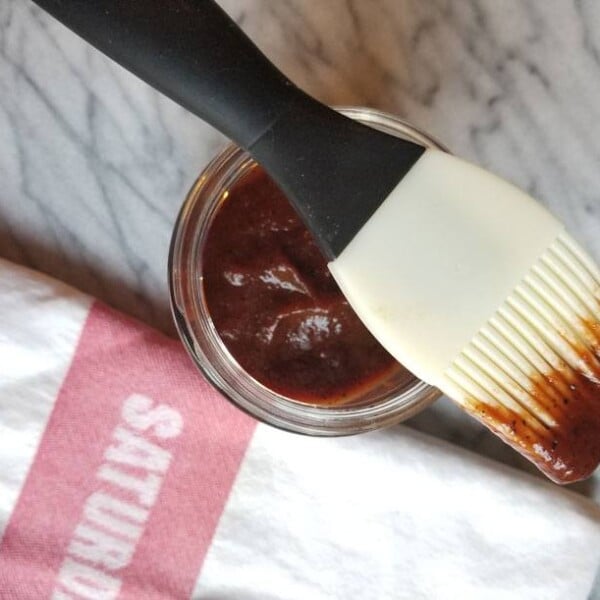
















any idea of the carbohydrate content of this wheat gluten? the packaged stuff is about 4 grams per serving. Do you think it would be about the same?
Hi Eric, I honestly am not sure and don’t even know how to figure that out for a recipe like this. I would imagine it’s not too different from the packaged stuff. Sorry I’m not more helpful!
According to the Weight Watchers eTools, a 2 oz. slice of seitan is 10g total carbs and 26g of protein.
Thanks for the welcome instructions. Just a question, is there a way to reduce how much water I use? 10 minutes of rinsing sounds like A LOT, and given that our region is suffering a drought, I need to be water-conscious. Any ideas? Could I re-use the water more than once, or does that defeat the purpose? Thanks!!!
the starch that is coming out of the flour is something you want to discard. By rewashing in the same water, you are just washing it in starchy water. You need to continually rinse it. It took 15 minutes for me to do a 2 pound bag of flour after soaking it for about 8 hours.
Hey Audrey, I live in the desert and while I took about 10 minutes or so to rinse it, I didn’t leave the water running the whole time. My process was more rinse-knead-repeat. I did fill up my bowl and knead until the water looked saturated with starch before dumping it and starting again. Hope that clarifies!
I rinse in a bowl and use the water on my plants. Good for them and avoids clogged sinks.
I followed this recipe step by step and something went very wrong. I soaked the dough over night, as mentioned. The next day it had really risen. Then after I spent 45 minutes kneading out the starch, I tried to use the strainer to get the water out. BIG MESS! It was so sticky I almost ruined my strained and spent 25 minutes of hard scrubbing and soap to clean the strainer. Now that I am boiling it, it looks like an ugly blob floating on top.
Any comments?
Think I’m done with making seitan.
Did you use self-rising flour?
Hey, it sounds like either you may have accidentally used self raising flour. Regular flour doesn’t have any leavening agents in it. Meaning it shouldn’t have risen if you used regular flour.
Or maybe when you left the dough to soak you didn’t cover it. Yeast naturally occurs in the air. If you leave dough out in the open the yeast from the air can settle on top of the dough. When the yeast combines with the gluten it results in a fermenting process. This is what causes dough to rise.
First, GREAT tips, and recipe! I did this for the first time last week using King Arthur Whole Wheat Flour, and it was FANTASTIC! So, I’m planning on doing some experimentation with this recipe, and first, I suspected, in order to lighten the color, I could use a white whole wheat flour. What ended up happening I don’t blame the flour for – but needless to say, it didn’t work. I do a lot of bread baking as well, and I had just finished the preparing the dough for a whole wheat baguette I was going to retard in the refrigerator. So, I started with the white whole wheat and water, everything the same, came together in the dough ball, covered it in water, and left it overnight to soak, same as before. To my surprise, this morning, the doughball had flattened out into more of a disc, risen to… Read more »
Just keep going, it does turn into a sloppy mess but then it comes back together again… It’s like magic!
Hi,
I tried this using whole wheat flour, but when I started to wash out the dough it completely disintegrated. It didn’t stay whole, so I had to transfer it to a sieve to get the milky water out. any ideas where i went wrong?
For those of you who grind your own wheat, do not use golden wheat. I got some from Azure Standard, and it works well for yeast bread, and other recipes, and is quite nice, but it does not have enough gluten for wheat meat. The other detail is that during the kneading and washing process, it does come apart for awhile, and then sticks together again, as the starch washes out. (Unless you used that golden wheat flour. Sigh.) I do use a sieve to hold it while it is coming apart during the washing process.
Thsnks for this. You mention that you can add spices etc in to the dough before rinsing- do they not just get washed out again?
Thank you for this recipe. I am looking forward to trying this. I have been living a vegan life since Late December and just recently tried BBQ seitan and fell in love. Now to be able to make it myself is a blessing. Thanks again.
Absolutely awesome, so fun to squish… Definitely soak overnight, though; the process of separating the gluten, bran and starch is intensive enough as it is. Thanks for this!
Thank you so much for this! I am so excited to try this. I am vegetarian and have fallen into that college convenience of prepackaged veggie burgers and such. I have seen so many recipes using seitan but could never find it in the store. I googled for a recipe and this came up! I am so excited to try this! Thanks again!